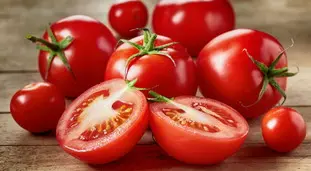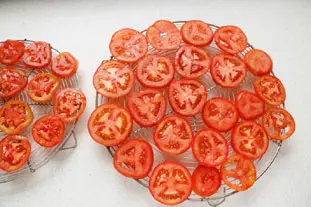The taste of raw tomatoes

Let's take a look at tomatoes, which are still in full bloom at the end of summer (as I write these lines), and which make for delicious salads.
I had already talked to you about the interest of peeling tomatoes, which gives them an extraordinary sweetness in the mouth, but let's talk about the taste this time. Of course, we are talking about seasonal tomatoes, which have grown in the area, and are both tasty and juicy.
I had already talked to you about the interest of peeling tomatoes, which gives them an extraordinary sweetness in the mouth, but let's talk about the taste this time. Of course, we are talking about seasonal tomatoes, which have grown in the area, and are both tasty and juicy.
13 K 4.9/5 (14 reviews)
Keywords for this post:TomatoesTasteSummerSeasonSaltJuiceExtractionLast modified on: September 8th 2018
The taste of raw tomatoes
Let's say you were going to make a salad with tomato slices, you might have peeled them (if not, try it as soon as possible!) and sliced them before putting them in your salad bowl. It's natural to do this, but it will have an unpleasant effect: when in contact with the dressing and the salt it contains, the tomato slices will give off a lot of juice, vegetation water in fact, and this juice will dilute the sauce in question. This means that if you prepare your tomato salad in advance, it is likely to be bathed in a very liquid juice-sauce mixture, which is not very pleasant.
Can this be avoided? Yes, there is a way to correct this problem, as in this recipe for example:
- You peel your tomatoes (if possible)
- You cut them into slices
- You lightly salt the tomato slices on each side with fine salt (very important)
- You put these salted slices on a grid, and you let them rest for 1 hour if possible, 30 minutes minimum
Doing it this way will have 2 effects:
1) The fine salt in contact with the tomato slices, will pump some of the water that will fall under the grill, which will "dry" the tomatoes a little, and all this water will not go into your salad afterwards.
2) The salt will enhance the taste of your tomatoes
After the resting time, drain carefully the slices, continue your tomato salad as you were used to, but think about reducing or removing the salt from your sauce, since you bring it with the tomatoes, and we must always be careful with salt in our diet.
This way of proceeding can also be applied for stuffed tomatoes for example: once hollowed out, salt the inside and put them upside down on a grid for 1 hour. Then use as usual.
To sum up: Before using tomatoes in a recipe, especially raw, it is always better to salt them with fine salt, and let them rest for a good hour so that the excess vegetation water escapes, and then use them normally.
What to do with the tomato water recovered in this way? Put it in a closed jar in the fridge, and pour it into a sauce or the cooking of your next recipe based on cooked tomatoes. Or... make yourself an amazing, clear Bloody-Mary!
Can this be avoided? Yes, there is a way to correct this problem, as in this recipe for example:
- You peel your tomatoes (if possible)
- You cut them into slices
- You lightly salt the tomato slices on each side with fine salt (very important)
- You put these salted slices on a grid, and you let them rest for 1 hour if possible, 30 minutes minimum

Doing it this way will have 2 effects:
1) The fine salt in contact with the tomato slices, will pump some of the water that will fall under the grill, which will "dry" the tomatoes a little, and all this water will not go into your salad afterwards.
2) The salt will enhance the taste of your tomatoes
After the resting time, drain carefully the slices, continue your tomato salad as you were used to, but think about reducing or removing the salt from your sauce, since you bring it with the tomatoes, and we must always be careful with salt in our diet.
This way of proceeding can also be applied for stuffed tomatoes for example: once hollowed out, salt the inside and put them upside down on a grid for 1 hour. Then use as usual.
To sum up: Before using tomatoes in a recipe, especially raw, it is always better to salt them with fine salt, and let them rest for a good hour so that the excess vegetation water escapes, and then use them normally.
What to do with the tomato water recovered in this way? Put it in a closed jar in the fridge, and pour it into a sauce or the cooking of your next recipe based on cooked tomatoes. Or... make yourself an amazing, clear Bloody-Mary!
Lasts posts
Always secure your cutting board
When using a cutting board, it's very important that it's stable and doesn't move while you're cutting, for safety's sake. Boards have a natural tendency to slide on the work surface, but here are 2 ways to block them effectively.July 1st 20256695
Cherry clafoutis, with or without pits?
When it comes to cherry clafoutis recipes, there's often a camp of those who argue that you absolutely have to leave the stones in because it tastes better, and the other camp (myself included) who prefer cherries without stones, which makes a much more pleasant clafoutis to eat. But is it true...June 29th 20257265
Should potatoes be washed twice?
Let's say you have to make a recipe that includes potatoes, let's say sliced, you'll most likely proceed as follows: Peel the potatoes, wash them, slice them, wash them again, pat them dry and add them to your recipe. But there's a "but": depending on the recipe, the second washing may be a bad...May 19th 20252,338 15
Grilled bacon is much better in the oven
Some recipes call for thin slices of bacon to be cooked and added to the recipe, or to prepare one of those delicious breakfasts known as "à l'Anglaise".April 25th 20252,0775
The thermometer is your friend
There are many recipes or foods that require a (very) precise cooking temperature: foie gras, sugar for caramel, meats and fish, and not forgetting pastries. For these few examples, getting the cooking temperature wrong can spoil the whole recipe or dish: undercooked, it's no good or misses the...April 10th 20252,3945
Other pages you may also like
Parmesan cheese crusts
If you use Parmesan cheese (Parmigiano Reggiano) in your recipes, you may have already noticed: when you grate it, it becomes (very) difficult near the crust, especially if it is a slightly aged parmesan, as the cheese gets harder and harder. So we stop grating, leaving some crust on top, and a...September 14th 202214 K4.8
What is the difference between bakery and patisserie?
This is a question that you may well have asked yourself and which I will attempt to answer. In France the two trades of "boulangerie" (bakery) and "pâtisserie" (patisserie and confectionery) have always been quite distinct, but where exactly do the boundaries lie? .February 7th 2017129 K 14.1
What can I use for blind baking a pastry case?
When it comes to home-made desserts, tarts are always popular. They can be divided into two basic types: those cooked with their filling, such as an apricot and almond cream tart, and those where the filling is added after baking the pastry case, such as a strawberry tart or chocolate tart. For...May 2nd 2017108 K4.5
The golden-brown finish on puff pastry
Let's take a look at the tricky matter of producing puff pastry with an attractive, golden-brown finish. French pastry chefs call this "dorure" (literally, "gilding"). Behind this quirky term there lurks a real problem (and the solution): when using puff pastry (pâte feuilletée) for a pie, or...February 8th 201844 K 24.6
Is it really necessary to cream egg yolks?
Let’s try and answer a question that crops up in cookery and patisserie, even if it verges on the existential: do the egg yolks in a custard recipe really need to be beaten until pale, or not?February 28th 201841 K4.3
Post a comment or question
Follow this page (as 2 people already do)
If you are interested in this page, you can "follow" it, by entering your email address here. You will then receive a notification immediately each time the page is modified or a new comment is added. Please note that you will need to confirm this following.
Note: We'll never share your e-mail address with anyone else.
Alternatively: you can subscribe to the mailing list of cooling-ez.com , you will receive a e-mail for each new recipe published on the site.









